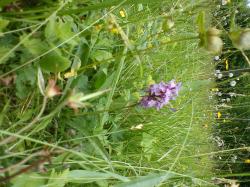Background

Semi-natural grasslands are one of the most species-rich habitats in Europe, with up to 600 plant species occurring in this habitat in Sweden. Due to modernised and intensified agricultural practices during the last century, areas previously occupied by grassland have been transformed into arable land or forest or been abandoned. The loss and fragmentation of semi-natural grasslands have had a negative effect on the biological diversity and conservation value of this habitat. Therefore, many of the species that rely on this habitat type is threatened today.
Both grazing and mowing are preferred management practices in semi-natural grasslands, as they remove the above-ground biomass and deplete grasslands of nutrients which helps maintain the plant species composition of semi-natural grasslands. However, there is no clear answer to which of grazing and mowing is best at ensuring the high conservation value of this habitat and few studies that have investigated this.
In addition, few studies have compared the effect of different mowing techniques. Traditionally, the scythe has been used when mowing semi-natural grasslands. During recent years the use of mechanical tools has become more common as they often are more time- and cost-effective. Cutting instruments like the scythe or knife mower are regarded as the preferred technique to use by managers and conservation biologists compared to other instruments like the grass trimmer. The rotating nylon rope of the grass trimmer is instead considered having a negative effect, as it tears the plant stems. However, no studies have experimentally confirmed any differences between mowing techniques or the negative effect of the grass trimmer on the grassland flora.
As the funds available for management and restoration of semi-natural grasslands are limited it is important to manage them as efficiently as possible and at the same time ensuring that the biological diversity and conservation value of this habitat is preserved.
Aim
The aim of my study was to examine which management method of grazing and mowing and which mowing technique best maintain the desired vegetation composition in semi-natural grasslands. This was done by analysing data from two long-term trials from the south of Sweden
Responsible for this page:
Director of undergraduate studies Biology
Last updated:
05/08/13
